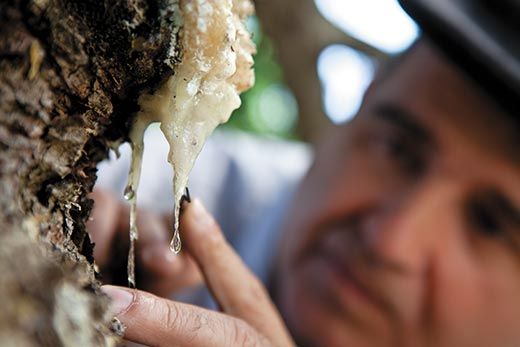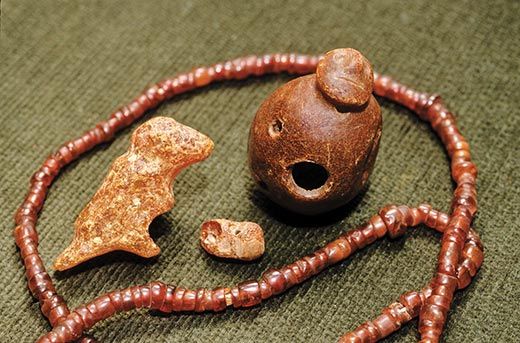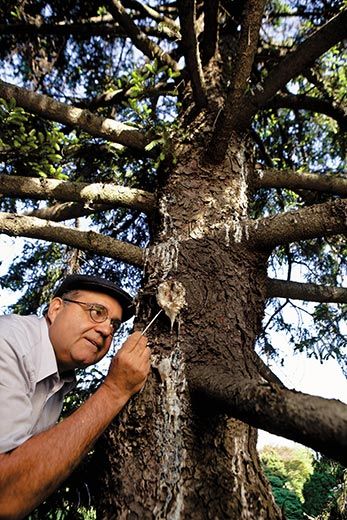Seeking the Origins of Amber
By studying the chemical signatures of living trees, Smithsonian’s Jorge Santiago-Blay intends to reconstruct ancient forests
/https://tf-cmsv2-smithsonianmag-media.s3.amazonaws.com/filer/Amber-Jorge-Santiago-Blay-631.jpg)
On a May morning in the National Arboretum in Washington, D.C., Jorge Santiago-Blay ducks under the branches of a Norway spruce to admire a thick white scab of resin that has oozed from where a branch was lopped off. Then, using a metal dental pick, he lifts a piece of crusty resin from a 15-foot-long streak under the floppy crown of an Oriental spruce.
Mornings like this make Santiago-Blay, 55, a biologist at Smithsonian’s National Museum of Natural History, sound a bit, well, sappy. “I feel so lucky to be doing this work,” he says, “because it means going to some of the most beautiful places on earth.”
The 446-acre arboretum is one of Santiago-Blay’s favorite collecting spots among the more than 50 botanical gardens he has visited across the country. Nearly 160 families of plants are known to seep “exudates”—such as resins or gums—when they are injured or diseased. That’s about half of all plant families, and his goal is to create a reference library of the substances. “Plant exudation is ubiquitous,” he says. With help from colleagues, he has gathered some 2,000 samples of amber and exudates from species found around the world and analyzed 1,245 of them.
Santiago-Blay hopes to use the samples to identify ancient amber and the trees and plants from which it came.
The impetus for the project was his suspicion, almost 25 years ago, that an amber-entombed scorpion he was studying was too immaculately preserved. “Could I have been fooled?” he remembers wondering. “Could this be a real scorpion in fake amber?”
Amber forms when tree resin is fossilized by high temperatures and pressure over millions of years. Artists value its clarity and color; people have been wearing jewelry of amber, which is relatively easily carved, for 13,000 years. Forgers have been pouring amber-like goo over flies, lizards and other “biological inclusions” for at least 600 years. Physical tests can identify some fakes; amber floats in salt water, generates a charge when rubbed and emits a piney scent when heated. But many counterfeits mimic even these properties of amber.
With his colleagues Joseph Lambert of Trinity University in San Antonio and Yuyang Wu of Northwestern University outside of Chicago, Santiago-Blay wants to work backward, comparing the molecular compositions of resins secreted by plants today with fossilized resins. The work has already been used to reveal that some pieces of amber in museum collections are, in fact, fakes. But the science has broader implications: identifying the plant that produced a sample of amber may shed light on prehistoric landscapes.
“It is one way to recreate probably what were among the dominant plants in a given habitat, and even in the broader ecosystem,” says Conrad Labandeira, a paleoecologist at the National Museum of Natural History.
“To me, it’s exciting,” says Santiago-Blay. “It’s like being a detective. I want to know where it came from so that I can begin to imagine, to picture, to recreate how the forest that produced the resin that eventually became amber looked. To make the forest grow again, so to speak—that is why I do this.”
/https://tf-cmsv2-smithsonianmag-media.s3.amazonaws.com/accounts/headshot/megan.png)



/https://tf-cmsv2-smithsonianmag-media.s3.amazonaws.com/accounts/headshot/megan.png)